|
MySQL 5.6.14 Source Code Document
|
|
MySQL 5.6.14 Source Code Document
|
Classes | |
| class | COND_CMP |
| struct | Key_field |
| Used when finding key fields. More... | |
| class | Plan_change_watchdog |
Macros | |
| #define | KEY_OPTIMIZE_EXISTS 1 |
| #define | KEY_OPTIMIZE_REF_OR_NULL 2 |
| #define | ICP_COND_USES_INDEX_ONLY 10 |
Functions | |
| void | reset_nj_counters (List< TABLE_LIST > *join_list) |
| Item_equal * | find_item_equal (COND_EQUAL *cond_equal, Field *field, bool *inherited_fl) |
| Item_field * | get_best_field (Item_field *item_field, COND_EQUAL *cond_equal) |
| Item * | build_equal_items (THD *thd, Item *cond, COND_EQUAL *inherited, bool do_inherit, List< TABLE_LIST > *join_list, COND_EQUAL **cond_equal_ref) |
| Item * | substitute_for_best_equal_field (Item *cond, COND_EQUAL *cond_equal, void *table_join_idx) |
| void | update_depend_map (JOIN *join) |
| bool | uses_index_fields_only (Item *item, TABLE *tbl, uint keyno, bool other_tbls_ok) |
| bool | is_indexed_agg_distinct (JOIN *join, List< Item_field > *out_args) |
| Key_use_array * | create_keyuse_for_table (THD *thd, TABLE *table, uint keyparts, Item_field **fields, List< Item > outer_exprs) |
| Item * | make_cond_for_table (Item *cond, table_map tables, table_map used_table, bool exclude_expensive_cond) |
| Item * | optimize_cond (THD *thd, Item *conds, COND_EQUAL **cond_equal, List< TABLE_LIST > *join_list, bool build_equalities, Item::cond_result *cond_value) |
| Item * | remove_eq_conds (THD *thd, Item *cond, Item::cond_result *cond_value) |
| bool | const_expression_in_where (Item *conds, Item *item, Item **comp_item) |
| uint | find_shortest_key (TABLE *table, const key_map *usable_keys) |
| bool | handle_select (THD *thd, select_result *result, ulong setup_tables_done_option) |
| bool | types_allow_materialization (Item *outer, Item *inner) |
| Check if two items are compatible wrt. materialization. | |
| bool | mysql_select (THD *thd, TABLE_LIST *tables, uint wild_num, List< Item > &fields, Item *conds, SQL_I_List< ORDER > *order, SQL_I_List< ORDER > *group, Item *having, ulonglong select_options, select_result *result, SELECT_LEX_UNIT *unit, SELECT_LEX *select_lex) |
| void | calc_used_field_length (THD *thd, JOIN_TAB *join_tab) |
| bool | create_ref_for_key (JOIN *join, JOIN_TAB *j, Key_use *org_keyuse, table_map used_tables) |
| bool | and_conditions (Item **e1, Item *e2) |
| bool | make_join_readinfo (JOIN *join, ulonglong options, uint no_jbuf_after) |
| bool | error_if_full_join (JOIN *join) |
| ORDER * | simple_remove_const (ORDER *order, Item *where) |
| bool | const_expression_in_where (Item *cond, Item *comp_item, Field *comp_field, Item **const_item) |
| int | test_if_order_by_key (ORDER *order, TABLE *table, uint idx, uint *used_key_parts) |
| bool | is_subkey (KEY_PART_INFO *key_part, KEY_PART_INFO *ref_key_part, KEY_PART_INFO *ref_key_part_end) |
| bool | is_ref_or_null_optimized (const JOIN_TAB *tab, uint ref_key) |
| bool | test_if_skip_sort_order (JOIN_TAB *tab, ORDER *order, ha_rows select_limit, const bool no_changes, const key_map *map, const char *clause_type) |
| void | count_field_types (SELECT_LEX *select_lex, TMP_TABLE_PARAM *param, List< Item > &fields, bool reset_with_sum_func) |
| bool | test_if_subpart (ORDER *a, ORDER *b) |
| void | calc_group_buffer (JOIN *join, ORDER *group) |
| void | free_underlaid_joins (THD *thd, SELECT_LEX *select) |
| uint | get_index_for_order (ORDER *order, TABLE *table, SQL_SELECT *select, ha_rows limit, bool *need_sort, bool *reverse) |
| uint | actual_key_parts (KEY *key_info) |
| uint | actual_key_flags (KEY *key_info) |
| void | JOIN_CACHE::calc_record_fields () |
| int | JOIN_CACHE::alloc_fields (uint external_fields) |
| void | JOIN_CACHE::create_flag_fields () |
| void | JOIN_CACHE::create_remaining_fields (bool all_read_fields) |
| void | JOIN_CACHE::set_constants () |
| bool | JOIN_CACHE::alloc_buffer () |
| int | JOIN_CACHE_BNL::init () |
| int | JOIN_CACHE_BKA::init () |
| bool | JOIN_CACHE_BKA::check_emb_key_usage () |
| uint | JOIN_CACHE_BKA::aux_buffer_incr () |
| uint | JOIN_CACHE_BKA::aux_buffer_min_size () const |
| bool | JOIN_CACHE_BKA::skip_index_tuple (range_seq_t rseq, char *range_info) |
| uint | JOIN_CACHE::write_record_data (uchar *link, bool *is_full) |
| virtual void | JOIN_CACHE::reset_cache (bool for_writing) |
| Reset the join buffer for reading/writing: default implementation. | |
| virtual bool | JOIN_CACHE::put_record_in_cache () |
| virtual bool | JOIN_CACHE::get_record () |
| virtual void | JOIN_CACHE::get_record_by_pos (uchar *rec_ptr) |
| virtual bool | JOIN_CACHE::get_match_flag_by_pos (uchar *rec_ptr) |
| int | JOIN_CACHE::read_some_record_fields () |
| void | JOIN_CACHE::read_some_flag_fields () |
| uint | JOIN_CACHE::read_record_field (CACHE_FIELD *copy, bool last_record) |
| bool | JOIN_CACHE::read_referenced_field (CACHE_FIELD *copy, uchar *rec_ptr, uint *len) |
| virtual bool | JOIN_CACHE::skip_record_if_match () |
| virtual void | JOIN_CACHE::restore_last_record () |
| enum_nested_loop_state | JOIN_CACHE::join_records (bool skip_last) |
| enum_nested_loop_state | JOIN_CACHE_BNL::join_matching_records (bool skip_last) |
| bool | JOIN_CACHE::set_match_flag_if_none (JOIN_TAB *first_inner, uchar *rec_ptr) |
| enum_nested_loop_state | JOIN_CACHE::generate_full_extensions (uchar *rec_ptr) |
| virtual bool | JOIN_CACHE::check_match (uchar *rec_ptr) |
| virtual enum_nested_loop_state | JOIN_CACHE::join_null_complements (bool skip_last) |
| enum_nested_loop_state | JOIN_CACHE_BKA::join_matching_records (bool skip_last) |
| bool | JOIN_CACHE_BKA::init_join_matching_records (RANGE_SEQ_IF *seq_funcs, uint ranges) |
| void | JOIN_CACHE::read_all_flag_fields_by_pos (uchar *rec_ptr) |
| virtual uint | JOIN_CACHE_BKA::get_next_key (uchar **key) |
| int | JOIN_CACHE_BKA_UNIQUE::init () |
| void | JOIN_CACHE_BKA_UNIQUE::reset_cache (bool for_writing) |
| Reset the join buffer for reading/writing: default implementation. | |
| bool | JOIN_CACHE_BKA_UNIQUE::put_record_in_cache () |
| bool | JOIN_CACHE_BKA_UNIQUE::get_record () |
| bool | JOIN_CACHE_BKA_UNIQUE::skip_record_if_match () |
| bool | JOIN_CACHE_BKA_UNIQUE::key_search (uchar *key, uint key_len, uchar **key_ref_ptr) |
| bool | JOIN_CACHE_BKA_UNIQUE::skip_index_tuple (range_seq_t rseq, char *range_info) |
| enum_nested_loop_state | JOIN_CACHE_BKA_UNIQUE::join_matching_records (bool skip_last) |
| virtual bool | JOIN_CACHE_BKA_UNIQUE::check_all_match_flags_for_key (uchar *key_chain_ptr) |
| uint | JOIN_CACHE_BKA_UNIQUE::get_next_key (uchar **key) |
| virtual bool | JOIN_CACHE_BKA_UNIQUE::check_match (uchar *rec_ptr) |
| int | JOIN::optimize () |
| bool | JOIN::update_equalities_for_sjm () |
| void | JOIN::set_semijoin_embedding () |
| bool | JOIN::flatten_subqueries () |
| void | JOIN::remove_subq_pushed_predicates (Item **where) |
| bool | JOIN::generate_derived_keys () |
| Add keys to derived tables'/views' result tables in a list. | |
| void | JOIN::drop_unused_derived_keys () |
| Drop unused keys for each materialized derived table/view. | |
| bool | JOIN::cache_const_exprs () |
| bool | JOIN::decide_subquery_strategy () |
| void | JOIN::refine_best_rowcount () |
| void | JOIN::reset () |
| bool | JOIN::prepare_result (List< Item > **columns_list) |
| bool | JOIN::explain () |
| bool | JOIN::destroy () |
| bool | JOIN::get_best_combination () |
| void | st_join_table::cleanup () |
| uint | st_join_table::sjm_query_block_id () const |
| bool | st_join_table::and_with_jt_and_sel_condition (Item *tmp_cond, uint line) |
| bool | st_join_table::and_with_condition (Item *tmp_cond, uint line) |
| Item * | st_join_table::unified_condition () const |
| void | JOIN::join_free () |
| void | JOIN::cleanup (bool full) |
| bool | JOIN::alloc_func_list () |
| bool | JOIN::make_sum_func_list (List< Item > &all_fields, List< Item > &send_fields, bool before_group_by, bool recompute=FALSE) |
| bool | JOIN::rollup_process_const_fields () |
| bool | JOIN::rollup_make_fields (List< Item > &all_fields, List< Item > &fields, Item_sum ***func) |
| void | JOIN::clear () |
| bool | JOIN::change_result (select_result *result) |
| bool | JOIN::add_sorting_to_table (JOIN_TAB *tab, ORDER_with_src *order) |
| Add Filesort object to the given table to sort if with filesort. | |
| uint actual_key_flags | ( | KEY * | key_info | ) |
Returns key flags depending on OPTIMIZER_SWITCH_USE_INDEX_EXTENSIONS flag.
| key_info | pointer to KEY structure |
Definition at line 5778 of file sql_select.cc.

| uint actual_key_parts | ( | KEY * | key_info | ) |
Returns number of key parts depending on OPTIMIZER_SWITCH_USE_INDEX_EXTENSIONS flag.
| key_info | pointer to KEY structure |
Definition at line 5761 of file sql_select.cc.

| bool JOIN::add_sorting_to_table | ( | JOIN_TAB * | tab, |
| ORDER_with_src * | order | ||
| ) |
Add Filesort object to the given table to sort if with filesort.
| tab | the JOIN_TAB object to attach created Filesort object to |
| order | List of expressions to sort the table by |
Definition at line 5364 of file sql_select.cc.

|
protected |
Allocate memory for a join buffer.
The function allocates a lump of memory for the join buffer. The size of the allocated memory is 'buff_size' bytes.
Definition at line 466 of file sql_join_buffer.cc.

| bool JOIN::alloc_func_list | ( | ) |
Make an array of pointers to sum_functions to speed up sum_func calculation.
| 0 | ok |
| 1 | Error |
Definition at line 4538 of file sql_select.cc.

Extend e1 by AND'ing e2 to the condition e1 points to. The resulting condition is fixed. Requirement: the input Items must already have been fixed.
| [in,out] | e1 | Pointer to condition that will be extended with e2 |
| e2 | Condition that will extend e1 |
| true | if there was a memory allocation error, in which case e1 remains unchanged |
| false | otherwise |
Definition at line 1860 of file sql_select.cc.

| bool JOIN_TAB::and_with_condition | ( | Item * | add_cond, |
| uint | line | ||
| ) |
Extend join_tab->cond by AND'ing add_cond to it
| add_cond | The condition to AND with the existing cond for this JOIN_TAB |
| line | Code line this method was called from |
| true | if there was a memory allocation error |
| false | otherwise |
Definition at line 3074 of file sql_select.cc.


| bool JOIN_TAB::and_with_jt_and_sel_condition | ( | Item * | add_cond, |
| uint | line | ||
| ) |
Extend join_tab->m_condition and join_tab->select->cond by AND'ing add_cond to them
| add_cond | The condition to AND with the existing conditions |
| line | Code line this method was called from |
| true | if there was a memory allocation error |
| false | otherwise |
Definition at line 3048 of file sql_select.cc.

|
protectedvirtual |
Calculate the increment of the MRR buffer for a record write
Reimplemented from JOIN_CACHE.
Definition at line 836 of file sql_join_buffer.cc.
|
protectedvirtual |
Calculate the minimume size for the MRR buffer
Calculate the minimume size for the MRR buffer.
Reimplemented from JOIN_CACHE.
Definition at line 862 of file sql_join_buffer.cc.
| Item* build_equal_items | ( | THD * | thd, |
| Item * | cond, | ||
| COND_EQUAL * | inherited, | ||
| bool | do_inherit, | ||
| List< TABLE_LIST > * | join_list, | ||
| COND_EQUAL ** | cond_equal_ref | ||
| ) |
Build multiple equalities for a condition and all on expressions that inherit these multiple equalities.
The function first applies the build_equal_items_for_cond function to build all multiple equalities for condition cond utilizing equalities referred through the parameter inherited. The extended set of equalities is returned in the structure referred by the cond_equal_ref parameter. After this the function calls itself recursively for all on expressions whose direct references can be found in join_list and who inherit directly the multiple equalities just having built.
Interesting that multiple equality =(t1.a,t2.a,t3.a,t4.a) allows us to use t1.a=t3.a AND t3.a=t4.a under the on condition:
This query equivalent to:
Similarly the original query can be rewritten to the query:
that is equivalent to:
Thus, applying equalities from the where condition we basically can get more freedom in performing join operations. Althogh we don't use this property now, it probably makes sense to use it in the future.
| thd | Thread handler | |
| cond | condition to build the multiple equalities for | |
| inherited | path to all inherited multiple equality items | |
| do_inherit | whether or not to inherit equalities from other parts of the condition | |
| join_list | list of join tables to which the condition refers to | |
| [out] | cond_equal_ref | pointer to the structure to place built equalities in |
Definition at line 1875 of file sql_optimizer.cc.


| bool JOIN::cache_const_exprs | ( | ) |
Cache constant expressions in WHERE, HAVING, ON conditions.
Definition at line 7256 of file sql_optimizer.cc.
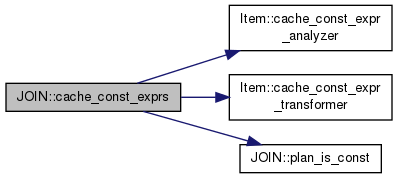

calc how big buffer we need for comparing group entries.
Definition at line 4448 of file sql_select.cc.

| void calc_used_field_length | ( | THD * | thd, |
| JOIN_TAB * | join_tab | ||
| ) |
Find how much space the prevous read not const tables takes in cache.
Definition at line 1263 of file sql_select.cc.
| bool JOIN::change_result | ( | select_result * | res | ) |
change select_result object of JOIN.
| res | new select_result object |
| FALSE | OK |
| TRUE | error |
Definition at line 4874 of file sql_select.cc.

|
protectedvirtual |
Check matching to a partial join record from the join buffer, an implementation specialized for JOIN_CACHE_BKA_UNIQUE. Only JOIN_CACHE_BKA_UNIQUE needs that, because it's the only cache using distinct keys. JOIN_CACHE_BKA, on the other hand, does one key lookup per cached record, so can take a per-record individualized decision for the pushed index condition as soon as it has the index tuple.
Reimplemented from JOIN_CACHE.
Definition at line 3393 of file sql_join_buffer.cc.
| void JOIN::cleanup | ( | bool | full | ) |
Cleanup this JOIN, possibly for reuse
Free resources of given join.
| fill | true if we should free all resources, call with full==1 should be last, before it this function can be called with full==0 |
Definition at line 3210 of file sql_select.cc.
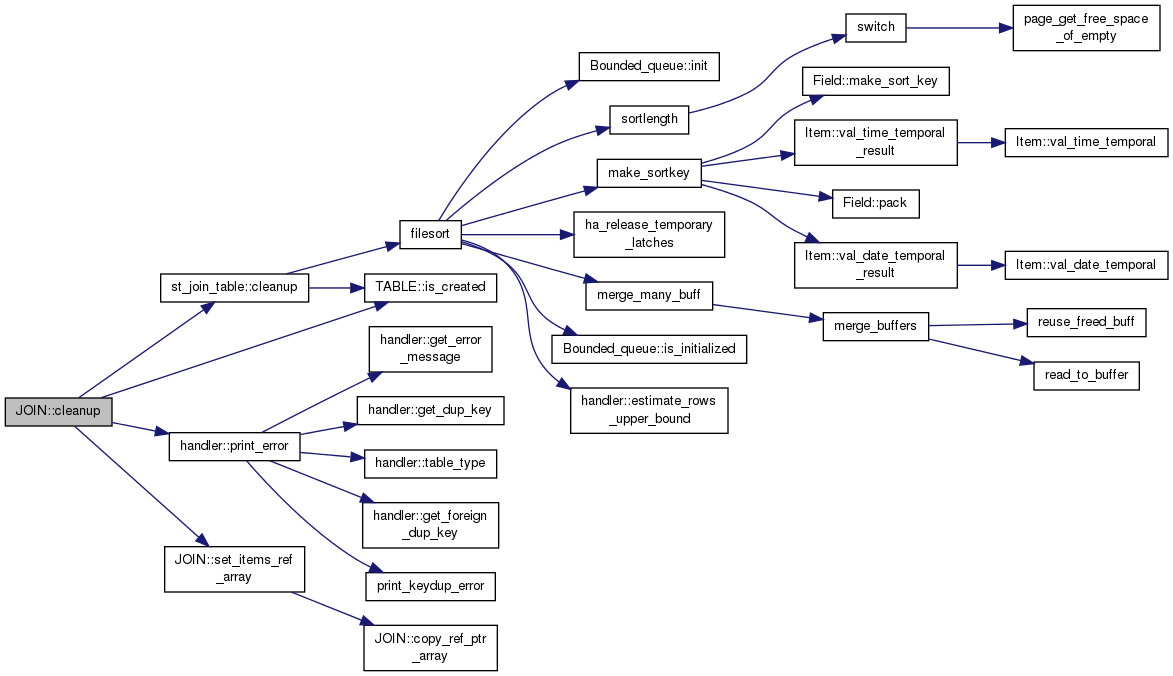

| void JOIN_TAB::cleanup | ( | ) |
Clean up associated table after query execution, including resources
Cleanup table of join operation.
Definition at line 2994 of file sql_select.cc.
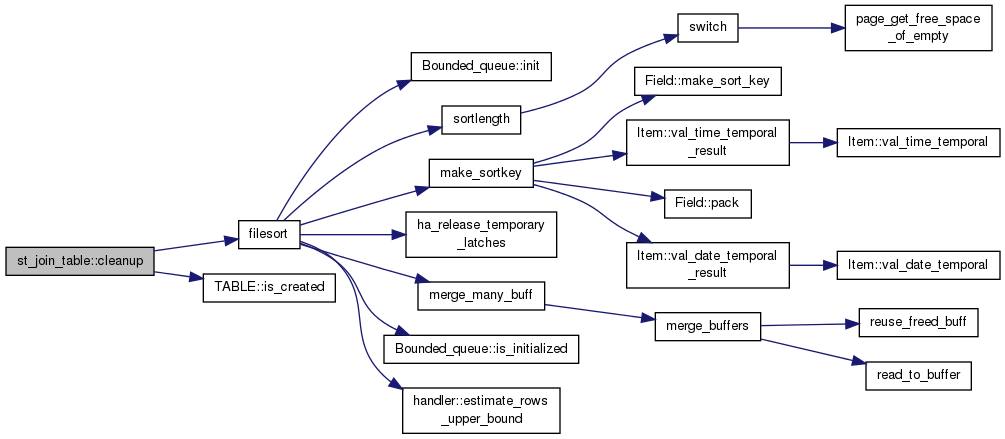

| void JOIN::clear | ( | ) |
clear results if there are not rows found for group (end_send_group/end_write_group)
Definition at line 4843 of file sql_select.cc.

| bool const_expression_in_where | ( | Item * | cond, |
| Item * | comp_item, | ||
| Field * | comp_field, | ||
| Item ** | const_item | ||
| ) |
Test if a field or an item is equal to a constant value in WHERE
| cond | WHERE clause expression | |
| comp_item | Item to find in WHERE expression (if comp_field != NULL) | |
| comp_field | Field to find in WHERE expression (if comp_item != NULL) | |
| [out] | const_item | intermediate arg, set to Item pointer to NULL |
Definition at line 3387 of file sql_select.cc.

| void count_field_types | ( | SELECT_LEX * | select_lex, |
| TMP_TABLE_PARAM * | param, | ||
| List< Item > & | fields, | ||
| bool | reset_with_sum_func | ||
| ) |
Update join with count of the different type of fields.
Definition at line 4371 of file sql_select.cc.

| Key_use_array* create_keyuse_for_table | ( | THD * | thd, |
| TABLE * | table, | ||
| uint | keyparts, | ||
| Item_field ** | fields, | ||
| List< Item > | outer_exprs | ||
| ) |
Create a keyuse array for a table with a primary key. To be used when creating a materialized temporary table.
| thd | THD pointer, for memory allocation |
| table | Table object representing table |
| keyparts | Number of key parts in the primary key |
| outer_exprs | List of items used for key lookup |
Definition at line 6002 of file sql_optimizer.cc.
Setup a ref access for looking up rows via an index (a key).
| join | The join object being handled |
| j | The join_tab which will have the ref access populated |
| first_keyuse | First key part of (possibly multi-part) key |
| used_tables | Bitmap of available tables |
This function will set up a ref access using the best key found during access path analysis and cost analysis.
Definition at line 1602 of file sql_select.cc.
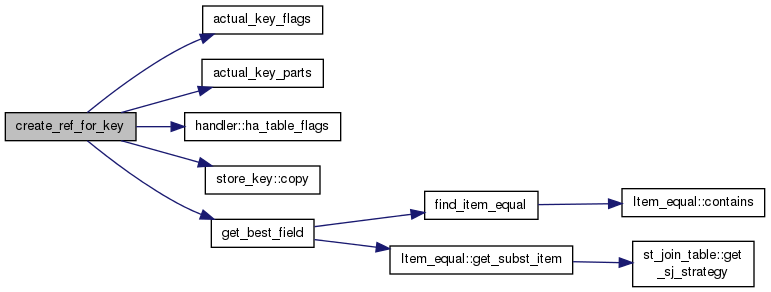

| bool JOIN::decide_subquery_strategy | ( | ) |
Decides between EXISTS and materialization; performs last steps to set up the chosen strategy.
Definition at line 9496 of file sql_optimizer.cc.

| bool JOIN::destroy | ( | ) |
Clean up and destroy join object.
Definition at line 893 of file sql_select.cc.
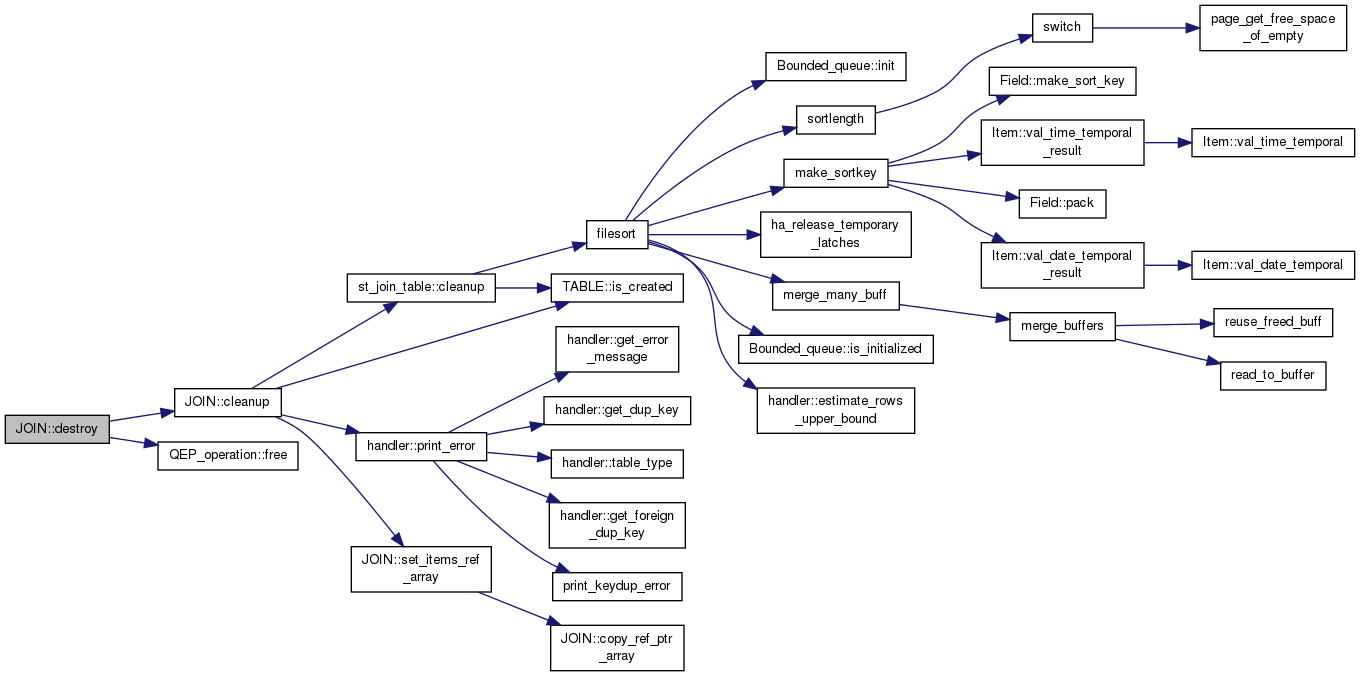
| void JOIN::drop_unused_derived_keys | ( | ) |
Drop unused keys for each materialized derived table/view.
For each materialized derived table/view, call TABLE::use_index to save one index chosen by the optimizer and ignore others. If no key is chosen, then all keys will be ignored.
Definition at line 7198 of file sql_optimizer.cc.


| bool error_if_full_join | ( | JOIN * | join | ) |
Give error if we some tables are done with a full join.
This is used by multi_table_update and multi_table_delete when running in safe mode.
| join | Join condition |
| 0 | ok |
| 1 | Error (full join used) |
Definition at line 2966 of file sql_select.cc.
| bool JOIN::explain | ( | ) |
Explain join.
Definition at line 839 of file sql_select.cc.

| Item_equal* find_item_equal | ( | COND_EQUAL * | cond_equal, |
| Field * | field, | ||
| bool * | inherited_fl | ||
| ) |
Find the multiple equality predicate containing a field.
The function retrieves the multiple equalities accessed through the con_equal structure from current level and up looking for an equality containing field. It stops retrieval as soon as the equality is found and set up inherited_fl to TRUE if it's found on upper levels.
| cond_equal | multiple equalities to search in | |
| field | field to look for | |
| [out] | inherited_fl | set up to TRUE if multiple equality is found on upper levels (not on current level of cond_equal) |
Definition at line 1150 of file sql_optimizer.cc.


Find shortest key suitable for full table scan.
| table | Table to scan |
| usable_keys | Allowed keys |
Definition at line 3611 of file sql_select.cc.

| void free_underlaid_joins | ( | THD * | thd, |
| SELECT_LEX * | select | ||
| ) |
Free joins of subselect of this select.
| thd | THD pointer |
| select | pointer to st_select_lex which subselects joins we will free |
Definition at line 4638 of file sql_select.cc.

| bool JOIN::generate_derived_keys | ( | ) |
Add keys to derived tables'/views' result tables in a list.
| select_lex | generate derived keys for select_lex's derived tables |
This function generates keys for all derived tables/views of the select_lex to which this join corresponds to with help of the TABLE_LIST:generate_keys function.
Definition at line 7170 of file sql_optimizer.cc.

| bool JOIN::get_best_combination | ( | ) |
Set up JOIN_TAB structs according to the picked join order in best_positions. This allocates execution structures so may be called only after we have the very final plan. It must be called after Optimize_table_order::fix_semijoin_strategies().
Notice that intermediate tables will not have a POSITION reference; and they will not have a TABLE reference before the final stages of code generation.
Definition at line 1328 of file sql_select.cc.

| Item_field* get_best_field | ( | Item_field * | item_field, |
| COND_EQUAL * | cond_equal | ||
| ) |
Get the best field substitution for a given field.
If the field is member of a multiple equality, look up that equality and return the most appropriate field. Usually this is the equivalenced field belonging to the outer-most table in the join order, but
| item_field | The field that we are seeking a substitution for. |
| cond_equal | multiple equalities to search in |
Definition at line 1188 of file sql_optimizer.cc.


| uint get_index_for_order | ( | ORDER * | order, |
| TABLE * | table, | ||
| SQL_SELECT * | select, | ||
| ha_rows | limit, | ||
| bool * | need_sort, | ||
| bool * | reverse | ||
| ) |
Find a key to apply single table UPDATE/DELETE by a given ORDER
| order | Linked list of ORDER BY arguments | |
| table | Table to find a key | |
| select | Pointer to access/update select->quick (if any) | |
| limit | LIMIT clause parameter | |
| [out] | need_sort | TRUE if filesort needed |
| [out] | reverse | TRUE if the key is reversed again given ORDER (undefined if key == MAX_KEY) |
Definition at line 5662 of file sql_select.cc.

| bool handle_select | ( | THD * | thd, |
| select_result * | result, | ||
| ulong | setup_tables_done_option | ||
| ) |
This handles SELECT with and without UNION
Definition at line 74 of file sql_select.cc.


|
virtual |
Initialize operation's internal state. Called once per query execution.
Implements JOIN_CACHE.
Definition at line 499 of file sql_join_buffer.cc.

|
virtual |
Initialize operation's internal state. Called once per query execution.
Implements JOIN_CACHE.
Reimplemented in JOIN_CACHE_BKA_UNIQUE.
Definition at line 549 of file sql_join_buffer.cc.


|
virtual |
Initialize operation's internal state. Called once per query execution.
Reimplemented from JOIN_CACHE_BKA.
Definition at line 2639 of file sql_join_buffer.cc.

| bool is_indexed_agg_distinct | ( | JOIN * | join, |
| List< Item_field > * | out_args | ||
| ) |
Check for the presence of AGGFN(DISTINCT a) queries that may be subject to loose index scan.
Check if the query is a subject to AGGFN(DISTINCT) using loose index scan (QUICK_GROUP_MIN_MAX_SELECT). Optionally (if out_args is supplied) will push the arguments of AGGFN(DISTINCT) to the list
Check for every COUNT(DISTINCT), AVG(DISTINCT) or SUM(DISTINCT). These can be resolved by Loose Index Scan as long as all the aggregate distinct functions refer to the same fields. Thus:
SELECT AGGFN(DISTINCT a, b), AGGFN(DISTINCT b, a)... => can use LIS SELECT AGGFN(DISTINCT a), AGGFN(DISTINCT a) ... => can use LIS SELECT AGGFN(DISTINCT a, b), AGGFN(DISTINCT a) ... => cannot use LIS SELECT AGGFN(DISTINCT a), AGGFN(DISTINCT b) ... => cannot use LIS etc.
| join | the join to check | |
| [out] | out_args | Collect the arguments of the aggregate functions to a list. We don't worry about duplicates as these will be sorted out later in get_best_group_min_max. |
| true | it does |
| false | AGGFN(DISTINCT) must apply distinct in it. |
Definition at line 5584 of file sql_optimizer.cc.


| bool is_ref_or_null_optimized | ( | const JOIN_TAB * | tab, |
| uint | ref_key | ||
| ) |
Test if REF_OR_NULL optimization will be used if the specified ref_key is used for REF-access to 'tab'
| true | JT_REF_OR_NULL will be used |
| false | no JT_REF_OR_NULL access |
Definition at line 3687 of file sql_select.cc.
|
inline |
Test if a second key is the subkey of the first one.
| key_part | First key parts |
| ref_key_part | Second key parts |
| ref_key_part_end | Last+1 part of the second key |
| 1 | is a subkey |
| 0 | no sub key |
Definition at line 3668 of file sql_select.cc.
| void JOIN::join_free | ( | ) |
Release memory and, if possible, the open tables held by this execution plan (and nested plans). It's used to release some tables before the end of execution in order to increase concurrency and reduce memory consumption.
Partially cleanup JOIN after it has executed: close index or rnd read (table cursors), free quick selects.
This function is called in the end of execution of a JOIN, before the used tables are unlocked and closed.
For a join that is resolved using a temporary table, the first sweep is performed against actual tables and an intermediate result is inserted into the temprorary table. The last sweep is performed against the temporary table. Therefore, the base tables and associated buffers used to fill the temporary table are no longer needed, and this function is called to free them.
For a join that is performed without a temporary table, this function is called after all rows are sent, but before EOF packet is sent.
For a simple SELECT with no subqueries this function performs a full cleanup of the JOIN and calls mysql_unlock_read_tables to free used base tables.
If a JOIN is executed for a subquery or if it has a subquery, we can't do the full cleanup and need to do a partial cleanup only.
Definition at line 3141 of file sql_select.cc.
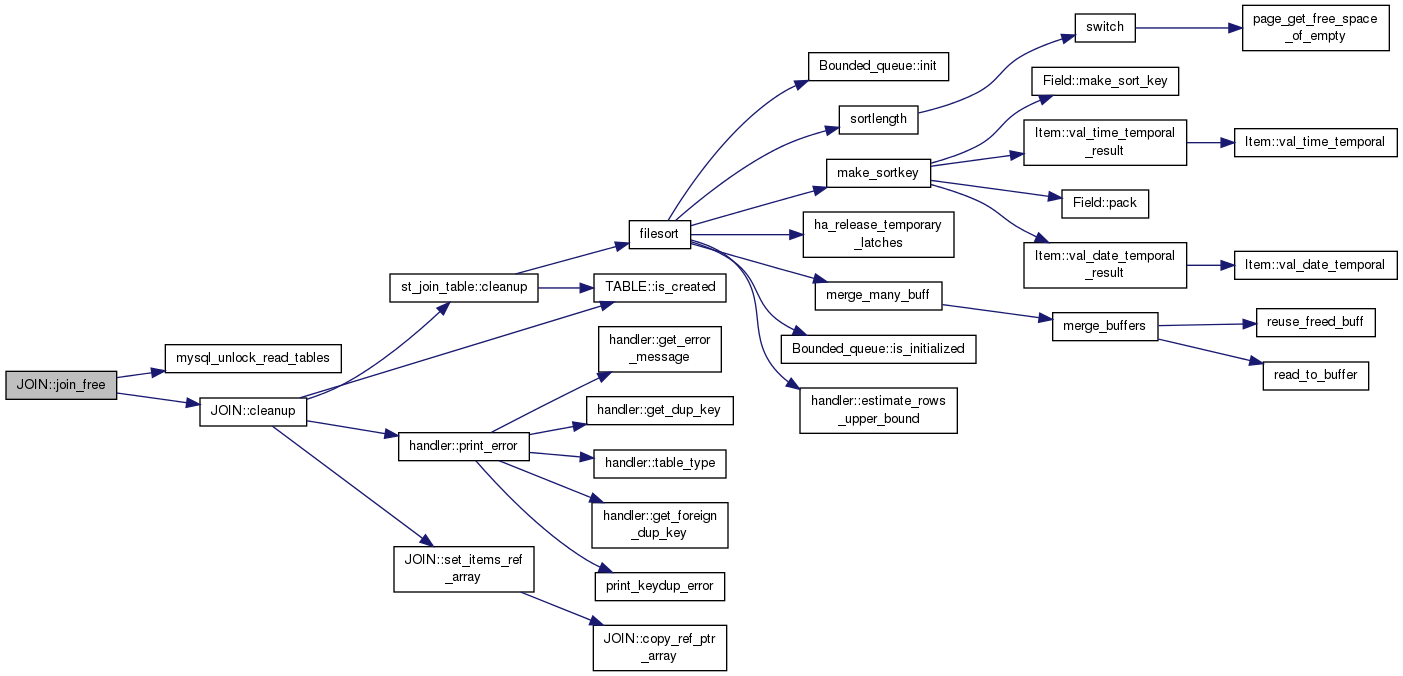
| Item* make_cond_for_table | ( | Item * | cond, |
| table_map | tables, | ||
| table_map | used_table, | ||
| bool | exclude_expensive_cond | ||
| ) |
Extract a condition that can be checked after reading given table
| cond | Condition to analyze |
| tables | Tables for which "current field values" are available |
| used_table | Table(s) that we are extracting the condition for (may also include PSEUDO_TABLE_BITS, and may be zero) |
| exclude_expensive_cond | Do not push expensive conditions |
| <>NULL | Generated condition |
| = | NULL Already checked, OR error |
Extract the condition that can be checked after reading the table(s) specified in used_table, given that current-field values for tables specified in tables bitmap are available. If used_table is 0, extract conditions for all tables in tables.
This function can be used to extract conditions relevant for a table in a join order. Together with its caller, it will ensure that all conditions are attached to the first table in the join order where all necessary fields are available, and it will also ensure that a given condition is attached to only one table. To accomplish this, first initialize tables to the empty set. Then, loop over all tables in the join order, set used_table to the bit representing the current table, accumulate used_table into the tables set, and call this function. To ensure correct handling of const expressions and outer references, add the const table map and OUTER_REF_TABLE_BIT to used_table for the first table. To ensure that random expressions are evaluated for the final table, add RAND_TABLE_BIT to used_table for the final table.
The function assumes that constant, inexpensive parts of the condition have already been checked. Constant, expensive parts will be attached to the first table in the join order, provided that the above call sequence is followed.
The call order will ensure that conditions covering tables in tables minus those in used_table, have already been checked.
The function takes into account that some parts of the condition are guaranteed to be true by employed 'ref' access methods (the code that does this is located at the end, search down for "EQ_FUNC").
Definition at line 7367 of file sql_optimizer.cc.

| bool make_join_readinfo | ( | JOIN * | join, |
| ulonglong | options, | ||
| uint | no_jbuf_after | ||
| ) |
Plan refinement stage: do various setup things for the executor
| join | Join being processed |
| options | Join's options (checking for SELECT_DESCRIBE, SELECT_NO_JOIN_CACHE) |
| no_jbuf_after | Don't use join buffering after table with this number. |
Plan refinement stage: do various set ups for the executioner
Definition at line 2769 of file sql_select.cc.
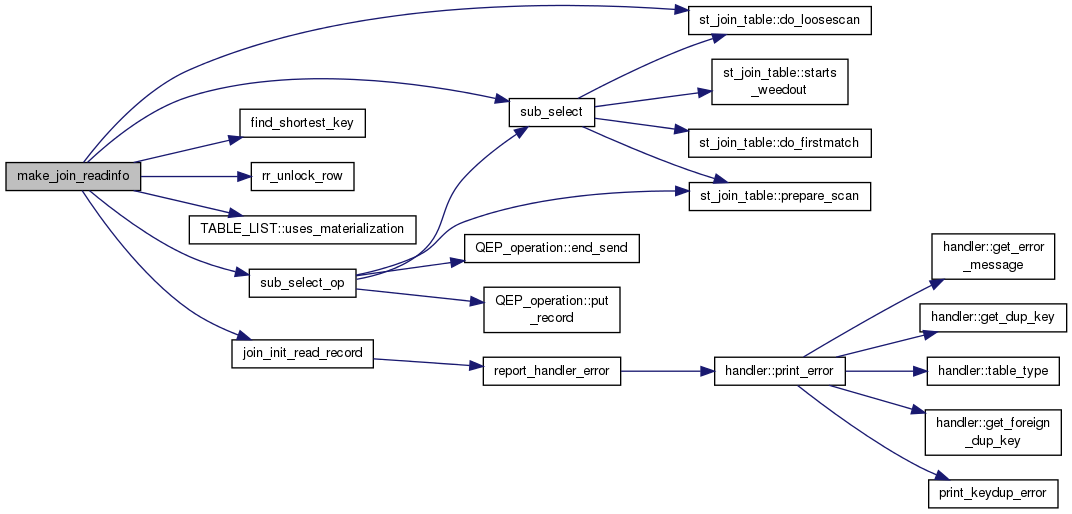

| bool JOIN::make_sum_func_list | ( | List< Item > & | field_list, |
| List< Item > & | send_result_set_metadata, | ||
| bool | before_group_by, | ||
| bool | recompute = FALSE |
||
| ) |
Initialize 'sum_funcs' array with all Item_sum objects.
| field_list | All items |
| send_result_set_metadata | Items in select list |
| before_group_by | Set to 1 if this is called before GROUP BY handling |
| recompute | Set to TRUE if sum_funcs must be recomputed |
| 0 | ok |
| 1 | error |
Definition at line 4593 of file sql_select.cc.


| bool mysql_select | ( | THD * | thd, |
| TABLE_LIST * | tables, | ||
| uint | wild_num, | ||
| List< Item > & | fields, | ||
| Item * | conds, | ||
| SQL_I_List< ORDER > * | order, | ||
| SQL_I_List< ORDER > * | group, | ||
| Item * | having, | ||
| ulonglong | select_options, | ||
| select_result * | result, | ||
| SELECT_LEX_UNIT * | unit, | ||
| SELECT_LEX * | select_lex | ||
| ) |
An entry point to single-unit select (a select without UNION).
| thd | thread handler |
| tables | list of all tables used in this query. The tables have been pre-opened. |
| wild_num | number of wildcards used in the top level select of this query. For example statement SELECT *, t1.*, catalog.t2.* FROM t0, t1, t2; has 3 wildcards. |
| fields | list of items in SELECT list of the top-level select e.g. SELECT a, b, c FROM t1 will have Item_field for a, b and c in this list. |
| conds | top level item of an expression representing WHERE clause of the top level select |
| order | linked list of ORDER BY agruments |
| group | linked list of GROUP BY arguments |
| having | top level item of HAVING expression |
| select_options | select options (BIG_RESULT, etc) |
| result | an instance of result set handling class. This object is responsible for send result set rows to the client or inserting them into a table. |
| unit | top-level UNIT of this query UNIT is an artificial object created by the parser for every SELECT clause. e.g. SELECT * FROM t1 WHERE a1 IN (SELECT * FROM t2) has 2 unions. |
| select_lex | the only SELECT_LEX of this query |
| false | success |
| true | an error |
Definition at line 1153 of file sql_select.cc.


| int JOIN::optimize | ( | ) |
global select optimisation.
| 0 | success |
| 1 | error |
Push joins to handler(s) whenever possible. The handlers will inspect the QEP through the AQP (Abstract Query Plan), and extract from it whatewer it might implement of pushed execution. It is the responsibility if the handler to store any information it need for later execution of pushed queries.
Currently pushed joins are only implemented by NDB. It only make sense to try pushing if > 1 non-const tables.
Set up access functions for the tables as required by the selected access type.
Definition at line 117 of file sql_optimizer.cc.
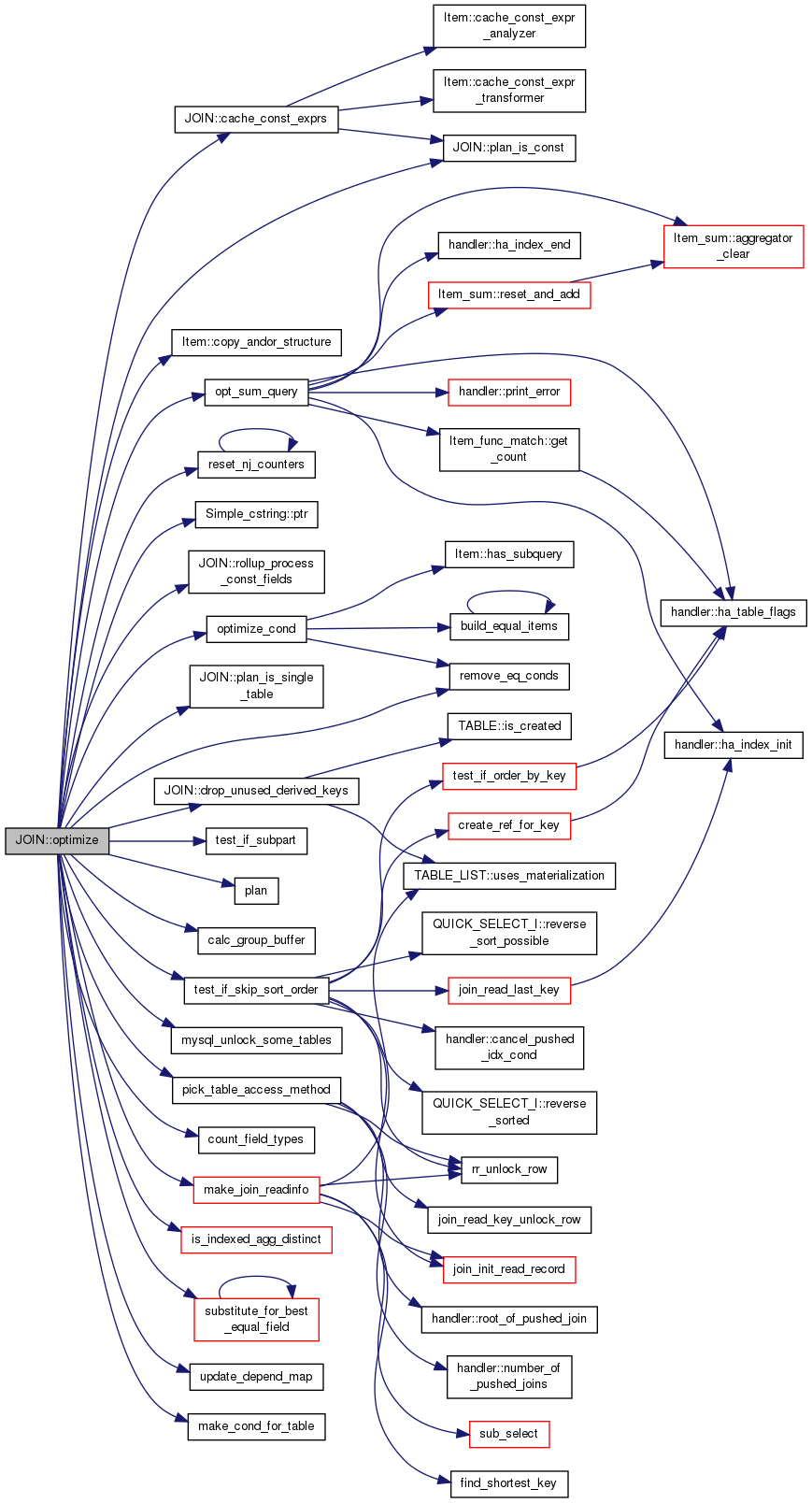

| Item* optimize_cond | ( | THD * | thd, |
| Item * | conds, | ||
| COND_EQUAL ** | cond_equal, | ||
| List< TABLE_LIST > * | join_list, | ||
| bool | build_equalities, | ||
| Item::cond_result * | cond_value | ||
| ) |
Optimize conditions by
a) applying transitivity to build multiple equality predicates (MEP): if x=y and y=z the MEP x=y=z is built. b) apply constants where possible. If the value of x is known to be 42, x is replaced with a constant of value 42. By transitivity, this also applies to MEPs, so the MEP in a) will become 42=x=y=z. c) remove conditions that are impossible or always true
| join | pointer to the structure providing all context info for the query | |
| conds | conditions to optimize | |
| join_list | list of join tables to which the condition refers to | |
| [out] | cond_value | Not changed if conds was empty COND_TRUE if conds is always true COND_FALSE if conds is impossible COND_OK otherwise |
Definition at line 8388 of file sql_optimizer.cc.
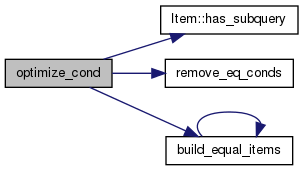

Prepare join result.
Prepare join result prior to join execution or describing. Instantiate derived tables and get schema tables result if necessary.
Definition at line 809 of file sql_select.cc.

|
protected |
Reads all flag fields of a positioned record from the join buffer. Including all flag fields (of this record) stored in the previous join buffers.
| rec_ptr | position of the first field of the record in the join buffer |
Definition at line 2451 of file sql_join_buffer.cc.


|
protected |
Read some flag fields of a record from the join buffer.
Reads all flag fields stored in this join buffer, for the current record (at 'pos'). If the buffer is incremental, flag fields of this record which are stored in previous join buffers are not read so remain unknown: caller must then make sure to call this function on previous buffers too.
The flag fields are read starting from the position 'pos'. The function increments the value of 'pos' by the length of the read data.
Flag fields are copied back to their source.
Definition at line 1420 of file sql_join_buffer.cc.
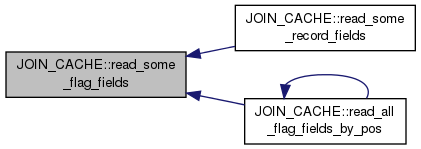
|
protected |
Read some flag and data fields of a record from the join buffer.
Reads all fields (flag and data fields) stored in this join buffer, for the current record (at 'pos'). If the buffer is incremental, fields of this record which are stored in previous join buffers are not read so remain unknown: caller must then make sure to call this function on previous buffers too.
The fields are read starting from the position 'pos' which is supposed to point to the beginning of the first record field. The function increments the value of 'pos' by the length of the read data.
Flag fields are copied back to their source; data fields are copied to the record's buffer.
| (-1) | if there are no more records in the join buffer |
| <>(-1) | length of the data read from the join buffer |
Definition at line 1385 of file sql_join_buffer.cc.

| void JOIN::refine_best_rowcount | ( | ) |
Refine the best_rowcount estimation based on what happens after tables have been joined: LIMIT and type of result sink.
Definition at line 9764 of file sql_optimizer.cc.

Remove const and eq items. Return new item, or NULL if no condition cond_value is set to according: COND_OK query is possible (field = constant) COND_TRUE always true ( 1 = 1 ) COND_FALSE always false ( 1 = 2 )
SYNPOSIS remove_eq_conds() thd THD environment cond the condition to handle cond_value the resulting value of the condition
NOTES calls the inner_remove_eq_conds to check all the tree reqursively
RETURN *Item with the simplified condition
Definition at line 8662 of file sql_optimizer.cc.

| void JOIN::reset | ( | void | ) |
Reset the state of this join object so that it is ready for a new execution.
Definition at line 747 of file sql_select.cc.
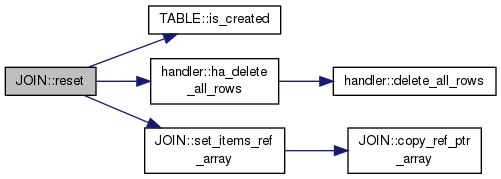
|
virtual |
Reset the join buffer for reading/writing: default implementation.
| for_writing | if it's TRUE the function reset the buffer for writing |
This default implementation of the virtual function reset_cache() resets the join buffer for reading or writing. If the buffer is reset for reading only the 'pos' value is reset to point to the very beginning of the join buffer. If the buffer is reset for writing additionally:
Reimplemented in JOIN_CACHE_BKA_UNIQUE.
Definition at line 1201 of file sql_join_buffer.cc.

|
virtual |
Reset the join buffer for reading/writing: default implementation.
| for_writing | if it's TRUE the function reset the buffer for writing |
This default implementation of the virtual function reset_cache() resets the join buffer for reading or writing. If the buffer is reset for reading only the 'pos' value is reset to point to the very beginning of the join buffer. If the buffer is reset for writing additionally:
Reimplemented from JOIN_CACHE.
Definition at line 2724 of file sql_join_buffer.cc.
| void reset_nj_counters | ( | List< TABLE_LIST > * | join_list | ) |
Set NESTED_JOIN::counter=0 in all nested joins in passed list.
Recursively set NESTED_JOIN::counter=0 for all nested joins contained in the passed join_list.
| join_list | List of nested joins to process. It may also contain base tables which will be ignored. |
Definition at line 1088 of file sql_optimizer.cc.


| bool JOIN::rollup_make_fields | ( | List< Item > & | fields_arg, |
| List< Item > & | sel_fields, | ||
| Item_sum *** | func | ||
| ) |
Fill up rollup structures with pointers to fields to use.
Creates copies of item_sum items for each sum level.
| fields_arg | List of all fields (hidden and real ones) |
| sel_fields | Pointer to selected fields |
| func | Store here a pointer to all fields |
| 0 | if ok; In this case func is pointing to next not used element. |
| 1 | on error |
Definition at line 4720 of file sql_select.cc.

| bool JOIN::rollup_process_const_fields | ( | ) |
Wrap all constant Items in GROUP BY list.
For ROLLUP queries each constant item referenced in GROUP BY list is wrapped up into an Item_func object yielding the same value as the constant item. The objects of the wrapper class are never considered as constant items and besides they inherit all properties of the Item_result_field class. This wrapping allows us to ensure writing constant items into temporary tables whenever the result of the ROLLUP operation has to be written into a temporary table, e.g. when ROLLUP is used together with DISTINCT in the SELECT list. Usually when creating temporary tables for a intermidiate result we do not include fields for constant expressions.
| 0 | if ok |
| 1 | on error |
Definition at line 4671 of file sql_select.cc.

| void JOIN::set_semijoin_embedding | ( | ) |
Set semi-join embedding join nest pointers.
Set pointer to embedding semi-join nest for all semi-joined tables. Note that this must be done for every table inside all semi-join nests, even for tables within outer join nests embedded in semi-join nests. A table can never be part of multiple semi-join nests, hence no ambiguities can ever occur. Note also that the pointer is not set for TABLE_LIST objects that are outer join nests within semi-join nests.
Definition at line 3827 of file sql_optimizer.cc.
Filter out ORDER items those are equal to constants in WHERE
This function is a limited version of remove_const() for use with non-JOIN statements (i.e. single-table UPDATE and DELETE).
| order | Linked list of ORDER BY arguments |
| cond | WHERE expression |
Definition at line 3290 of file sql_select.cc.
| uint JOIN_TAB::sjm_query_block_id | ( | ) | const |
Definition at line 3030 of file sql_select.cc.

| bool JOIN_CACHE_BKA_UNIQUE::skip_index_tuple | ( | range_seq_t | rseq, |
| char * | range_info | ||
| ) |
Check if the record combination matches the index condition
| rseq | Value returned by bka_range_seq_init() |
| range_info | MRR range association data |
| false | The record combination satisfies the index condition |
| true | Otherwise |
Reimplemented from JOIN_CACHE_BKA.
Definition at line 3153 of file sql_join_buffer.cc.
| Item* substitute_for_best_equal_field | ( | Item * | cond, |
| COND_EQUAL * | cond_equal, | ||
| void * | table_join_idx | ||
| ) |
Substitute every field reference in a condition by the best equal field and eliminate all multiple equality predicates.
The function retrieves the cond condition and for each encountered multiple equality predicate it sorts the field references in it according to the order of tables specified by the table_join_idx parameter. Then it eliminates the multiple equality predicate it replacing it by the conjunction of simple equality predicates equating every field from the multiple equality to the first field in it, or to the constant, if there is any. After this the function retrieves all other conjuncted predicates substitute every field reference by the field reference to the first equal field or equal constant if there are any.
| cond | condition to process |
| cond_equal | multiple equalities to take into consideration |
| table_join_idx | index to tables determining field preference |
Definition at line 2180 of file sql_optimizer.cc.


Test if one can use the key to resolve ORDER BY.
| order | Sort order |
| table | Table to sort |
| idx | Index to check |
| used_key_parts | [out] NULL by default, otherwise return value for used key parts. |
| 1 | key is ok. |
| 0 | Key can't be used |
| -1 | Reverse key can be used |
Definition at line 3474 of file sql_select.cc.


| bool test_if_skip_sort_order | ( | JOIN_TAB * | tab, |
| ORDER * | order, | ||
| ha_rows | select_limit, | ||
| const bool | no_changes, | ||
| const key_map * | map, | ||
| const char * | clause_type | ||
| ) |
Test if we can skip the ORDER BY by using an index.
SYNOPSIS test_if_skip_sort_order() tab order select_limit no_changes map
If we can use an index, the JOIN_TAB / tab->select struct is changed to use the index.
The index must cover all fields in <order>, or it will not be considered.
| tab | NULL or JOIN_TAB of the accessed table |
| order | Linked list of ORDER BY arguments |
| select_limit | LIMIT value, or HA_POS_ERROR if no limit |
| no_changes | No changes will be made to the query plan. |
| map | key_map of applicable indexes. |
| clause_type | "ORDER BY" etc for printing in optimizer trace |
| 0 | We have to use filesort to do the sorting |
| 1 | We can use an index. |
Definition at line 3864 of file sql_select.cc.
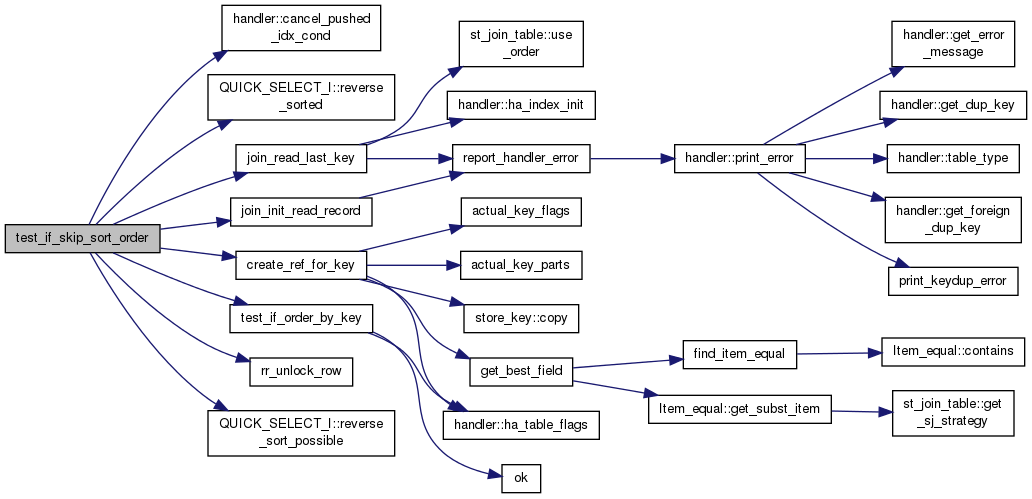

Return 1 if second is a subpart of first argument.
If first parts has different direction, change it to second part (group is sorted like order)
Definition at line 4431 of file sql_select.cc.

Check if two items are compatible wrt. materialization.
| outer | Expression from outer query |
| inner | Expression from inner query |
| TRUE | If subquery types allow materialization. |
| FALSE | Otherwise. |
Definition at line 138 of file sql_select.cc.

| Item * JOIN_TAB::unified_condition | ( | ) | const |
Check if JOIN_TAB condition was moved to Filesort condition. If yes then return condition belonging to Filesort, otherwise return condition belonging to JOIN_TAB.
Definition at line 3092 of file sql_select.cc.
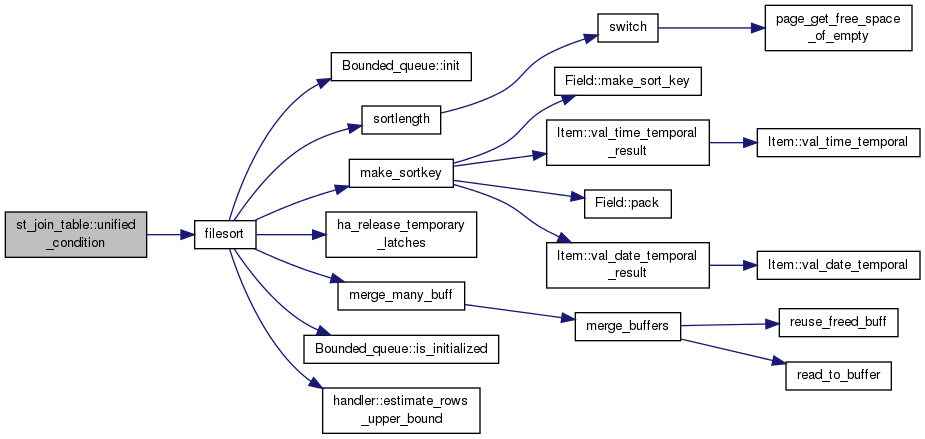
| void update_depend_map | ( | JOIN * | join | ) |
Update the dependency map for the tables.
Definition at line 2891 of file sql_optimizer.cc.

| bool JOIN::update_equalities_for_sjm | ( | ) |
Update equalities and keyuse references after semi-join materialization strategy is chosen.
For each multiple equality that contains a field that is selected from a subquery, and that subquery is executed using a semi-join materialization strategy, add the corresponding column in the materialized temporary table to the equality. For each injected semi-join equality that is not converted to multiple equality, replace the reference to the expression selected from the subquery with the corresponding column in the temporary table.
This is needed to properly reflect the equalities that involve injected semi-join equalities when materialization strategy is chosen.
The MaterializeScan semi-join strategy requires some additional processing: All primary tables after the materialized temporary table must be inspected for keyuse objects that point to expressions from the subquery tables. These references must be replaced with references to corresponding columns in the materialized temporary table instead. Those primary tables using ref access will thus be made to depend on the materialized temporary table instead of the subquery tables.
Only the injected semi-join equalities need this treatment, other predicates will be handled correctly by the regular item substitution process.
Definition at line 2973 of file sql_optimizer.cc.

